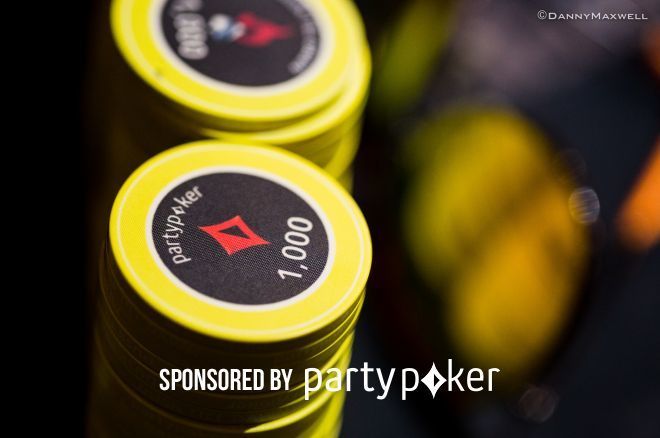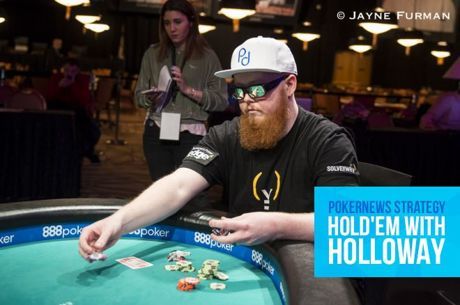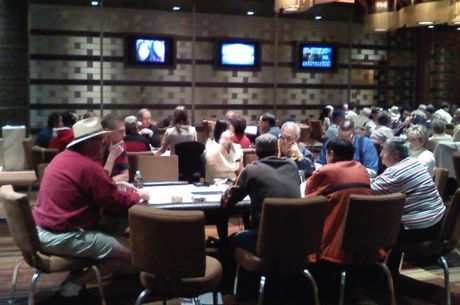Learn to Notice When Your Hand Blocks Bluffs, Too

Sometimes a hand that is strong enough to call the turn becomes less so on the river, even when that river seems to be a total blank.
When an opponent keeps firing barrels on every postflop street, thereby making his or her range polarized between value hands and total bluffs, the decision to call that last river bet with a medium-strength hand sometimes means checking your own hand for blockers not just to value hands, but for blockers to bluffs, too.
The following is a real hand from a real internet poker game with two grinders clicking buttons on opposite sides of the globe. The hand provides us an example of a player reaching the river with just such a medium-strength hand, but failing to recognize he actually blocks the bluffs he hopes his opponent might have when firing the third barrel.
A Monotone Flop
It's an online poker game of 100NL no-limit hold'em, blinds $0.50/$1 and played six-max. A player in middle position opened the pot to $3, then a regular in the small blind three-bet to $10 and the opener just called.
The flop came all diamonds �� A?10?4? �� and the small blind decided to check.
Many players have an unbalanced checking range when they are out of position on flops such as this. In general though, the small blind should have many hands that would like to check, such as kings, queens, and jacks, both with a diamond and (especially) without.
The in-position player already has a more polarized range on this flop. For every flush combination that player holds, there are three complete airballs (e.g., for every 9?8? there are clubs, spades, and hearts). The middle-position player is also less likely to hold offsuit hands compared to the small blind, simply by virtue of the preflop action.
The small blind player would prefer to keep these airball hands in the range of their opponent, speaking to the problem with having a betting range. But could not the small blind then bluff many hands?
In fact, the in-position player will also have, or should have, enough AxXx and 10xXx hands, as well as stronger hands like 10x10x and flushes, to handle a deluge of bluffs.
More Action on the Turn
After being checked to, the middle-position player bet $12 into about $20 and the small blind called. The turn was the 7? and the small blind checked again.
Not much will have changed for the small blind's range. After checking this flop, the small blind will often be planning to check-call the turn. Hands like 9x9x without a diamond should check and fold, while hands like K?Q? would either bet the flop or check-fold.
The decision to check and call the flop has revealed some particular strength in the small blind's hand, but we can also infer that the small blind doesn't have a vulnerable value hand such as 10x10x or 6?5? that wants to get money into the pot but doesn't want to give free cards. Seeing a flop check from these hands would be unusual.
If the small blind thought his opponent capable of firing three times, however, checking these hands as well as AxK? would ensure that the small blind can have the nuts after check-calling three times, regardless of whether the board pairs, a fourth diamond arrives, or a fourth diamond does not arrive.
In any case, it is hard to conceive of a hand that might check-call the flop from the small blind that would now, on a total blank, feel apprehensive and fold to a second barrel, especially when that second postflop bet is on the small side, as was the case when the middle-position player bet $17 into $44. (By the same token, all those total misses in the middle-position player's hand like 6?5? should often get cold feet on this turn card, given the situation.)
The small blind indeed called.
A River Blank and a Third Barrel
With $78 now in the middle, the river was the 2?, making the final board A?10?4?7?2?.
The small blind checked a third time, and the in-position player moved all in for $61. The small blind made a heroic call with Q?Q?. But the queens were not good, as the middle-position player held A?10?.
Notice that after the turn the small blind could still make the second nuts on eight cards, a set on two cards, and the nuts on the K?. The small blind had showdown value �� that is, he could win unimproved if the river action is check-check �� and he also still had equity going to the river against hands as strong as 10x10x and 6?5?.
However, that changes for these specific two hole cards on this blank river. Q?Q? blocks KxQx, QxJx, and the Q? particularly, which would all be potential bluffing hands for the middle-position player �� that is, holdings with no showdown value but some equity or potential on the turn.
Yes, the small blind's hand blocks K?Q?, Q?J?, and Q?9? as well as AxQ?, all value hands with which the middle-position player could have taken this line. But on balance, on this river, the cards in the small blind's hand are doing him more harm than good, as it relates to what his opponent holds.
Therefore, those queens become a great candidate to check-fold the river, having checked and called on the turn.
This strategy article by Gareth Chantler for PokerNews is sponsored by partypoker.









